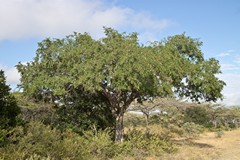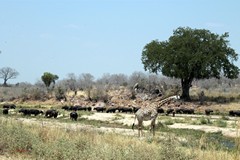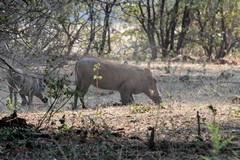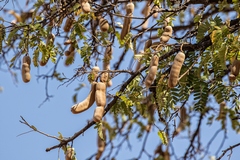Tamarind (Tamarindus indica) leguminous tree in the family Fabaceae and is probably indigenous to tropical Africa. The genus Tamarindus has only a single species.

Tamarind with seed pods in Ruaha National
Park
It was first identified and named in India, hence its latin name. It is for this reason that the tamarind has come to be so completely identified with India. It was re-imported to Africa at some point by Indian tradesmen and administrators to the Island of Zanzibar where a population of the tree became established. In the 16th Century it was introduced into Mexico and parts of South America.
The Tamarind is a long-lived, medium sized, bushy tree, which usually attains a maximum crown height of 12 to 18 metres, but can reach 30m under favourable conditions.
The trunk can be up to 7.5m in circumference. The crown has an irregular, outline of dense dark green foliage.
The tree grows well in full sun in clay, loam, sandy, and acidic soil types, and has a high drought and aerosol salt resistance, so it can grow in arid places and also coastal districts. It is easy to spot along the river banks in Ruaha, especially in the dry season.
Leaves are semi evergreen, pinnate, and 7.5-15 cm in length, each having 10 to 20 pairs of oblong leaflets 1.25-2.5 cm long and 5-6 wide. The branches droop from a single, central trunk as the tree matures. At night, the leaflets close up. The leaves may be shed briefly in very dry areas during the hot season.

The trees are easy to spot along the
riverbanks in the dry season
The tamarind produces fairly inconspicuous red and yellow elongated flowers. Flowers are 2.5 cm wide, five-petalled, borne in small racemes, and yellow with orange or red streaks on them.
The fruit is a pod, 12 to 15 cm in length, with a hard, brown shell. The fruit has a fleshy, juicy, acidulous pulp. It is mature when the inside is coloured brown or reddish-brown.
The hard green pulp of a young fruit is considered by many to be too sour, but is often used as a component of savory dishes, as a pickling agent.
The ripened fruit becomes sweeter and less sour (acidic) as it matures. It is used in desserts as a jam, blended into juices or sweetened drinks, sorbets, ice creams and all manner of snacks. In Western cuisine, it is found in Worcestershire sauce and HP sauce.
In southern Kenya, it is used to garnish vegetables and also make juices. In Somalia, it is used to give rice some sour flavour. In Nigeria, it is used with millet powder to prepare kunun tsamiya, a traditional breakfast dish, and usually eaten with bean cake. In Zimbabwe, the leaves are added to soup and the flowers are an ingredient in salads. In most parts of India, tamarind extract is used to flavour foods ranging from meals to snacks. It is also added to chutneys.
Dry weather is important during the period of fruit development. In South Malaysia, where there are frequent rains at this time, the tamarind does not bear fruit.

These warthogs are on their knees eating
fallen fruit
The fruit is a major food source for many animals. Warthog love to eat the fallen fruit, as do dik dik and duikers. They are a favourite of baboons and elephants, and also of lemurs in Madagascar.
In Africa the fruit pulp is used as a laxative. The roots are used as relief for coughs and fevers. The bark is boiled and taken for sore throats as well as a popular tea or hot drink. It also serves as a cure for diarrhoea and dysentery.
The health benefits of Tamarind have been well-studied and include the ability to reduce inflammation throughout the body, improve eye health, boost respiratory health, heal skin conditions, improve the digestive system, relieve pain, increase the strength of the immune system, teduce fever, lower cholesterol to improve cardiovascular health, treat piles, and prevent cancer.
It contains plenty of vitamin C, as well as vitamin E, B vitamins, calcium, iron, phosphorous, potassium, manganese, and fibre. There are also a number of organic compounds that make tamarind a powerful antioxidant.
Research is currently being undertaken with a compound known as xyloglucan, derived from tamarind seeds, which could help regrow damaged nerves in the brain and spinal chord. This may be useful in treating diseases such as Parkinson's

Tamarind fruit
Tamarind wood is a reddish color. Due to its density and durability, tamarind heartwood can be used in making furniture and wood flooring.
There is a superstition that it is harmful to sleep or to tie a horse beneath a Tamarind, which probably started because of the corrosive effect that fallen leaves have on fabrics in damp weather.
Some African tribes venerate the tamarind tree as sacred, and to some Burmese tribes, the tree represents the dwelling-place of the Rain God.
In Nyasaland, tamarind bark soaked with corn is given to domestic fowl in the belief that, if they stray or are stolen, it will cause them to return home.
In Malaysia, a little tamarind and coconut milk is placed in the mouth of an infant at birth, and the bark and fruit are given to elephants to make them wise.